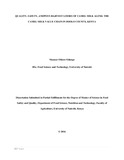| dc.description.abstract | Camel milk production is faced with a number of challenges, especially poor handling practices that contribute to milk post-harvest losses due to quality deterioration and safety. The handling practices are associated with an interaction of many risk factors and poor knowledge on food safety and hygiene among the camel milk value chain actors. This study aimed at determining the safety, quality and risk factors along the camel milk value chain and quantify the post-harvest losses resulting from the physiochemical and microbiological deterioration of the milk and finally to determine the prevalence of Campylobacter species, a possible food safety hazard, along the camel milk value chain. A survey was conducted among chain actors using structured questionnaires, focused group discussions and key informant interviews along the camel milk value chain to determine the level of knowledge on food hygiene and safety and the risk factors while the physiochemical and microbiological quality of the milk was done at Isiolo Teaching and Referral Hospital and department of Food Science, Nutrition and Technology, the University of Nairobi laboratories. The study established that herdsmen, with a mean score of 49.37% ± 8.99%, had significantly (p<0.05) lower food hygiene and safety knowledge than women retailing and bulking milk at Isiolo town The women at the collection centre had the highest food hygiene and safety knowledge with a score of 68.75% ± 9.84%; while retailing women in Isiolo scored 61.91% ± 9.29%. The average food hygiene and safety knowledge score along Isiolo camel milk value chain was 60.01% ± 9.37%. The spoiled/rejected milk along the value chain was either consumed at household level or sold. Major risk factor contributing to the deterioration of milk was poor hygiene at the herd level indicated by the high Staphylococcus aureus count of 1.4×104 cfu/cm2, 1.5×104 cfu/cm2 and 5.9×103 cfu/ml on the camel udder swab, milkers hand swab and the milking container, respectively. The other risk factor was poor disease management of the camels; sick and
xiv | P a g e
the healthy camels were milked together and the milk bulked in same containers. About 4% and 5% of milk delivered at bulking/cooling hub in Isiolo town and terminal market at Eastleigh area, Nairobi, respectively failed alcohol test. Total viable count (TVC) showed the highest variation (1.78x106 to 8.1x108) along the chain which did not show wide significance (p<0.05) difference while Staphylococcus aureus count showed the widest variation (1.3x104 to 2.0x106) along the chain. More milk was lost due to Total viable count standard than coliform counts standard. Hundred percent of milk at the terminal Eastleigh market, Nairobi were rejected due to TVC while about 93% were rejected due to coliform counts. The study established that the prevalence of Campylobacter species increased significantly (p<0.05) along the chain, with individual camel milk samples showing 9% prevalence and the final market milk samples in Nairobi Eastleigh area showed a Campylobacter prevalence of 51%. Out of all the Campylobacter positive samples only about 3% were identified as Campylobacter jejuni while Campylobacter coli was not detected in any of the samples. The study concluded that the poor milk handling practices and low food hygiene and safety knowledge constraints along the Isiolo camel milk value chain contribute a lot to milk quality and safety deterioration and post-harvest losses, hence economical loss along camel milk value chain. Therefore, training of the value chain actors can improve their knowledge on food hygiene and safety, hence reduce post-harvest losses.
Key words: Camel milk, physiochemical quality; microbiological deterioration, post-harvest losses, campylobacter prevalence | en_US |



